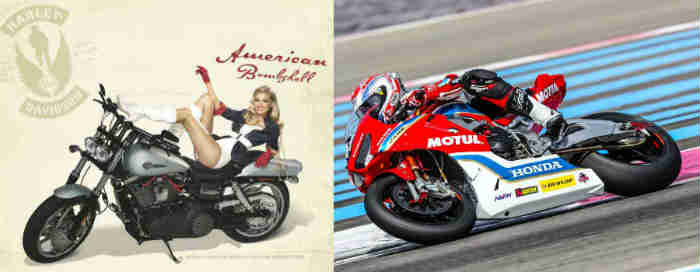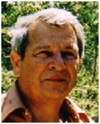Harleycans --(on the vroom side)

In my (much) younger years and on another continent, I was interested in motorbikes, like any other young male then. I even got my biking-license, requiring an actual "field test" (in the city) with all kinds of turns, etc. Of course, that was entirely separate from getting my car-driving license.
Somehow though, I never acquired a motorcycle myself. Instead, I rode my brother's ~20 HP bike a few times, never far, except as "passenger" or via a tow-line to my (pedal-powered) bicycle.
American Bikers
Those were the "good old days"--including, perhaps, a bit of (traffic-wise) unlawful activities -- even then and there. That was long before I ever set sight on any "HOG", originally a nickname dating back nearly 100 years that later became the stock market symbol for Harley-Davidson Inc. According to Wikipedia, "HOG" has also become
a generic term for large motorcycles.
When I first came to see "HOGs," I was astounded. Those machines and their riders were totally new to me. Even then, decades ago, these bikes were big, heavy, and more powerful bikes than I ever imagined. And their riders handled them with ease.
Actually, there is an event called "Friday, the 13
th"--that occurs a couple of times each year. That's when Harleycans and other bikers "re-unite" in the town of Port Dover, Ontario with thousands of gleaming machines, with and without attachments from one end of town to the other. Parking (for cars) is relegated to the outskirts of the town and shuttle buses get you downtown. It's truly amazing to see all that hardware and their owners, as well as their accompaniments in one small place and, of course, a boon for the place.
The twice annual biker get-together in Port Dover (population ca. 6,000) began in 1981 and has steadily grown ever since. At the latest gathering, a few days ago, an estimated 200,000
folks were visiting the place with many thousands of bikes
rolling through town.

European Bikers
Another observation that perplexed me early on was the riders' posture on such (HOG) bikes, sitting comfortably and leaning backwards and, with (in some models) supportive back rests. What a difference to the European bikes of the time.
In contrast to most Harley riders on a highway, the posture of European bike riders was the exact opposite. They were leaning forward with the knees sharply bent and trying to provide as little wind-resistance as possible. I don't think that much has changed since then (please, let me know if you disagree). Just to make it clear for any "non-biker," the nearby pictures may provide a visual explanation of that difference without any claim as to their authenticity or representativeness.
And the power of those heavy bikes (from any continent) is truly awesome; in fact, perhaps, "out of this world." Unless it's your fancy to shoot along a German "Autobahn" at 200-plus km/h (140-plus mph) or faster, I simply can't see any benefit of all that "raw power" and its associated costs.
Most likely, I think, one could just ride as comfortably on a machine with one-tenth of that power. I might be wrong (tell me if you can) but, if that's true (as I suspect it is), at least some HOG aficionados are slightly (?) "over-powered."
Sorry, have to end now, need to "oil" my aching joints.
And my apologies to any "rider" that I may have inadvertently offended, wherever.
Dr. Klaus L.E. Kaiser -- Bio and
Archives |
Comments
Dr. Klaus L.E. Kaiser is author of CONVENIENT MYTHS, the green revolution – perceptions, politics, and facts Convenient Myths

 In my (much) younger years and on another continent, I was interested in motorbikes, like any other young male then. I even got my biking-license, requiring an actual "field test" (in the city) with all kinds of turns, etc. Of course, that was entirely separate from getting my car-driving license.
Somehow though, I never acquired a motorcycle myself. Instead, I rode my brother's ~20 HP bike a few times, never far, except as "passenger" or via a tow-line to my (pedal-powered) bicycle.
In my (much) younger years and on another continent, I was interested in motorbikes, like any other young male then. I even got my biking-license, requiring an actual "field test" (in the city) with all kinds of turns, etc. Of course, that was entirely separate from getting my car-driving license.
Somehow though, I never acquired a motorcycle myself. Instead, I rode my brother's ~20 HP bike a few times, never far, except as "passenger" or via a tow-line to my (pedal-powered) bicycle.